|
Staff Newsletter | Minnesota Department of Natural Resources |
|
|
Nov. 17, 2023
In This Issue
|
|
Get Out MORE webpage is live
 The Minnesota Department of Natural Resources has launched a new webpage dedicated to information about the transformative Get Out MORE (Modernize Outdoor Recreation Experiences) investments approved during the 2023 legislative session.
On the page, the public can learn about how the $149.9 million in funding will enhance Minnesotans' experiences and the DNR's work in five key areas:
The page also features videos of funding supporters as well as DNR leadership and staff talking about how the investments will help Minnesotans of all abilities and interests enjoy a world-class recreation system. As we implement Get Out MORE investments over the next five-to-six years, we will update the page with information on the progress of specific projects and how the DNR is helping Minnesotans and visitors to our state Get Out MORE.
DNR strategic plan released
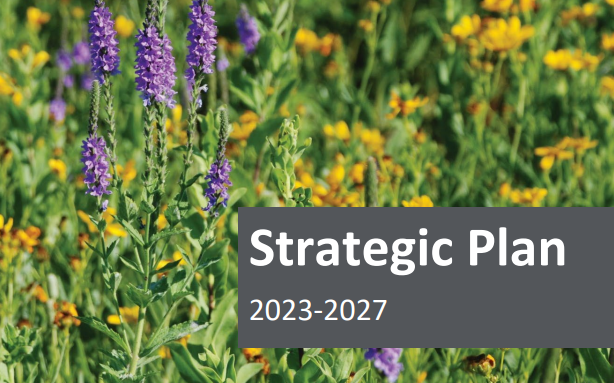 Gov. Tim Walz and Lt. Gov. Peggy Flanagan rolled out the One Minnesota Plan, which establishes a shared purpose, vision for the future, guiding principles and priority areas for the state of Minnesota. Similarly, the DNR released the agency strategic plan, which outlines goals, strategies, activities and performance metrics which align with the One Minnesota Plan and advance the DNR's mission.
The 2023-2027 agency strategic plan highlights alignment with the One Minnesota Plan, goals and strategies to achieve success, current agency priorities, and core agency structure and work. Successful implementation of the DNR strategic plan will help sustain and build nature-based recreational opportunities, increase the health and vitality of ecological systems, strengthen communities, and support a wide range of natural resource-dependent economic activities.
|
|
FY24 MnSAFE Workplace Safety Management Plan available
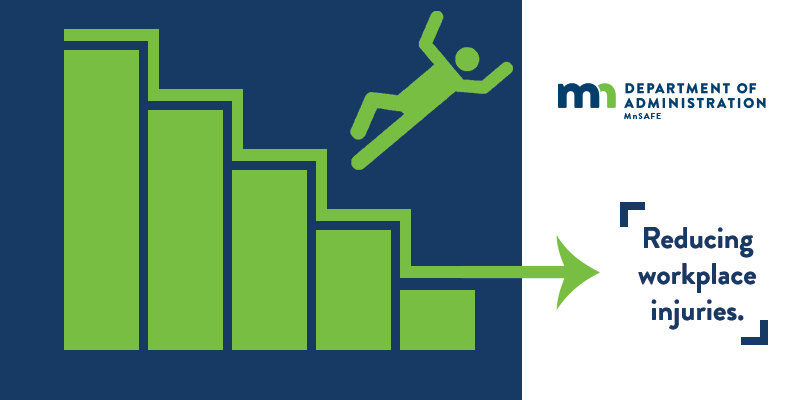 By Joni Akerson, acting safety and risk manager
The DNR, like all state agencies, is committed to creating a safe and healthy workplace. As part of this commitment, the DNR prepares an annual MnSAFE Workplace Safety Management Plan. The plan includes a summary of accomplishments from the previous fiscal year, performance metrics, and goals and objectives outlining how we intend to reduce the frequency and severity of injuries in the current fiscal year.
For FY24, our goals and objectives include:
- Improve our safety culture score by addressing the following action items from the FY23 safety perception survey:
- Safety performance is measured and shared.
- Lessons learned from accident investigations are shared.
- The risks with tasks we perform are properly evaluated.
- Identify negative trends in the DNR workers' compensation snapshot and develop a plan to correct the issues.
- Reverse the negative trend in the DNR's snapshot regarding tick bites by proactively addressing insect sting incidents and reducing the occurrence of fieldwork-associated tick bites and insect stings.
- Develop a plan to address slip, trip and fall incidents.
In FY23, Enforcement, Ecological and Water Resources, and Fish and Wildlife (Fisheries) all had reductions in the number of workplace incidents. The DNR did have a slight reduction in the total amount of reported injuries with 210, compared to 217 the previous fiscal year.
A Safety Stand-Up event was held in January and February, with mandatory attendance for all employees. The goal of this event was to reinforce the DNR's commitment to our safety culture and improve safety practices by engaging every DNR employee in safety discussions and activities led by supervisors and managers. Feedback from the event was given to divisional safety committees to use when planning activities and work for FY24.
We accomplished a lot together in FY23, and are well-positioned for continued progress in FY24. Also, I want to note our MnSAFE plan is one part of a larger effort to make the DNR a safe and healthy place to work. For more safety information and resources — including communication tools, reports, policies, training and more — visit the Safety and Health Intranet webpage.
For more information about MnSAFE, head to the Minnesota Department of Administration MnSAFE webpage. It takes all of us working together to reach our goals and make the DNR as safe a workplace as possible!
|
|
All-staff diversity, equity and inclusion events postponed
The diversity, equity and inclusion all-staff events announced in the Nov. 3 Spotlight have been rescheduled to January 2024.
All DNR staff and leadership will be required to attend at least one of the events. Please watch for a future announcement with the new dates.
Save the date for upcoming well-being webinars
 The Organizational Health Team’s Well-being Action Team is hosting several webinars on mental well-being in December and January — we hope you can join us! There will be an opportunity to submit questions prior to the sessions.
Dec. 13, noon (for all employees): Common questions about sick leave and mental health
An optional meeting invite will be sent to employees soon.
- Human Resources Director Denise Legato will cover common questions related to policies, such as:
- What is the policy for using sick leave for mental health reasons?
- When is it OK to take a “mental health day?"
- What details do I need to give my supervisor about my health?
- How can FMLA leave be taken for mental health reasons?
- Steven Reuter, Resolve consultant, will provide an overview of Employee Assistance Program (EAP) resources available to support mental well-being and some common questions.
Dec. 20, 1-2:30 p.m. (for all employees): Managing and navigating stress at work
This session is being offered through the Work EVO Upskill Challenge. Join the Upskill Challenge Teams channel to access the meeting appointment.
- Reuter will provide an overview of new research about stress. He will also share tips for addressing stressors so that we can reduce negative impacts of stress on our health. Attendees will learn how assessing our resources when we feel stressed can help us to address our stressors in a new and healthier way.
Jan. 18, noon (for supervisors and managers): Mental well-being skills and tools
An optional meeting invite will be sent to all managers and supervisors soon.
- Legato will share tips for risk management and engaging with an employee when you sense they might be going through a hard time. She will explain how the supervisor is expected to be a link to resources, but counseling staff is out of scope.
- Reuter will explain EAP resources for managers and supervisors and tips on sharing resources with employees.
- The Well-being Action Team will explain resources developed and posted for supervisors to use with their work teams (presentations about EAP resources, examples of how employees have used EAP, talking points, etc.)
Questions? Contact Laura Grunloh or any Well-being Action Team member.

It's snow! It's hail! It's... graupel?
 By Kenny Blumenfeld, climatologist
Under the heading of “things climatologists fight about” is a little-known type of wintry precipitation known as graupel (pronounced “graw-pul”).
Graupel is soft, fragile, and looks like teeny-tiny snowballs, or small Styrofoam pellets. It forms when a snowflake gets “rimed,” or ice-coated, by a collision with super-cooled water. (Physics review: super-cooled water is water that remains in a liquid state despite sub-freezing temperatures; this happens frequently in the atmosphere.)
In Minnesota, graupel tends to fall in brief showers or squalls, most frequently during the fall and spring when temperatures are near or above freezing. It can be accompanied by any other type of precipitation.
Meteorologists used to refer to graupel as “soft hail,” but it is not hail, which requires thunderstorm updrafts to produce either layers of ice or aggregations of ice chunks.
Graupel has also been referred to as “snow pellets,” but it’s not actually snow, because snow by definition is made solely of ice crystals, whereas graupel is snow coated with a layer of ice.
Some have argued that graupel is sleet, because they often fall in similar conditions and look alike, but sleet is falling water that freezes before hitting the ground (or re-freezes, because it often starts as a snowflake that melts). Graupel always has a snowflake on the inside; sleet never does.
So, graupel is graupel — a unique and lovely precipitation type unto itself!
|
|
Nominate a colleague for a
Commissioner's Award
 It’s time to recognize our coworkers for their outstanding work in 2023! Nominations opened this week for the annual Commissioner’s Awards.
The Commissioner’s Awards provide an opportunity to honor and celebrate individuals and teams throughout the DNR who have gone “above and beyond” in their work during 2023 and who exemplify the DNR's mission and values. Over the next few weeks, reflect on the many achievements of the past year and nominate colleagues who have been most critical to those successes. The nomination categories for 2023 are:
-
Natural Resources Conservation: The work meaningfully contributed to our efforts to conserve and enhance the state's waters, natural lands, and diverse fish and wildlife habitats.
-
Outdoor Recreation: The work greatly supported and promoted Minnesota's outdoor recreation opportunities in order to meet the needs of new and existing participants.
-
Sustainable Economic Use of Natural Resources: The work significantly contributed to our efforts to develop and sustain strong job markets, economies and communities across the state.
-
Operational Excellence: The work demonstrated operational excellence and continuous improvement in service to internal and external customers. This may include achievements in promoting a culture of safety at DNR.
The awards are intended to acknowledge work that occurred during 2023, or the final result of multi-year efforts that concluded in 2023.
Nominations will be open until Dec. 22.

Wireside Chats: Nov. 8, 2023
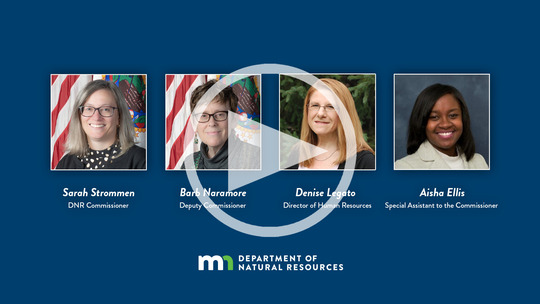 DNR Commissioner Sarah Strommen, Deputy Commissioner Barb Naramore, Human Resources Director Denise Legato and Special Assistant to the Commissioner Aisha Ellis joined the Nov. 8 Wireside Chats to discuss the DNR's updated strategic plan and Executive Order 23-14, which aims to improve recruitment and retention of state employees.
To watch previous Wireside Chats, including both of the Nov. 8 editions, head to the Commissioner's Wireside Chats Intranet page.
|
|
Free seminars, networking opportunities available via PEN
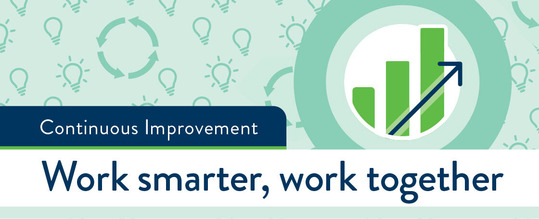 Learning and networking opportunities are available to all DNR and MNIT at DNR staff through our agency membership with the Performance Excellence Network.
The DNR’s membership includes access to bi-weekly, free online seminars that support staff development in improvement methods and innovation. DNR Continuous Improvement staff host a debrief session on Teams following most seminars for DNR employees to network and discuss application of the seminars to our work.
Past seminars have focused on: effective communication in changing work environments, managing change, best practices in managing a team, increasing resiliency under stress, and mitigating unconscious bias.
Join the DNR Continuous Improvement group on Microsoft Teams to receive notifications of seminars, registration links, and other continuous improvement learning opportunities. You can join the free seminars through the links posted in Teams, or by registering on your own and selecting the “Member event fee $0” option. Employees are welcome to view past seminar recordings in the on-demand library.
Upcoming free seminars include:
Registration for longer events (half or full-day workshops and conferences) are available at a reduced cost member rate.
Questions? Contact Laura Grunloh or Yengmy Thao.
|
|
Technology tips, updates
Transferring ownership of a Microsoft Form
To transfer the form of someone who has left the organization, the following requirements must be met:
- The form must be transferred within 30 days of when an account was deleted.
- The former owner's account has not yet been deleted.
While there can't be more than one individual owner of a form, there can be collaborators. A better option is to move form ownership to a group, like a Microsoft Team. This should eliminate the potential of the form disappearing, unless the team that owns it is deleted, and anyone who is a part of the team can edit the form and download the results.
Updating the default editing option in Microsoft Teams
By default, Teams opens all documents in the web browser view, which does not provide as many features as the desktop versions. To change this feature:
- Locate a file in Teams.
- Add a check next to it on the left.
- An "open" pull-down will appear in the top menu, where you can change the default from "open in browser" to "open in app."
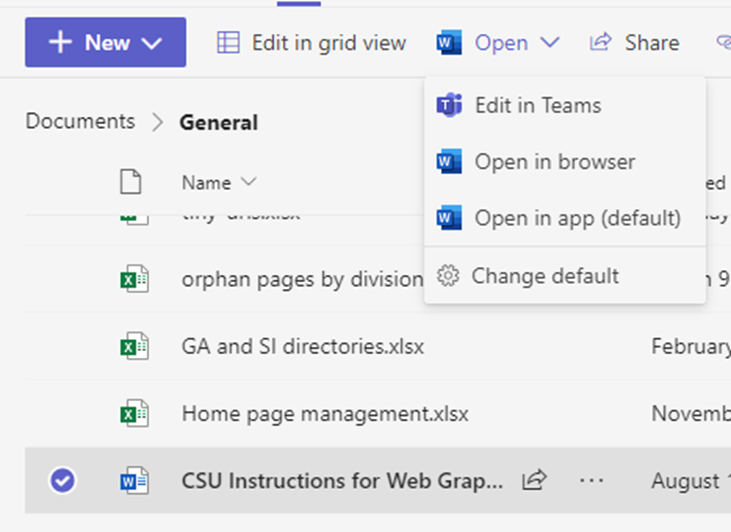 Encrypted emails changing
As part of an effort to protect encrypted messages, Microsoft is updating how encrypted emails look and work.
Encrypting an email message in Outlook means it's converted from readable, plain text into scrambled, cipher text. Only the recipient can decipher the message for reading and anyone other than the recipient would see indecipherable text.
- If you send an encrypted email by adding a keyword in the subject line, the recipient of that email might notice it looks and functions differently.
- If you use the options > encrypt button in Outlook to send a message, nothing will change for the recipient.
Previously, if you sent an encrypted email by using a keyword, the recipient's email included an attachment. The recipient would select the HTML attachment, and the encrypted message would open in a browser:
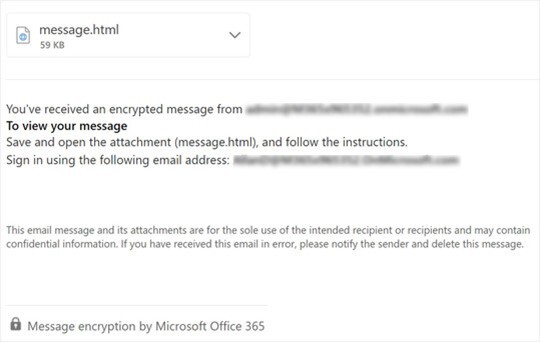 Now, recipients select a "read this message" link to open messages. The encrypted message will open in a browser window:
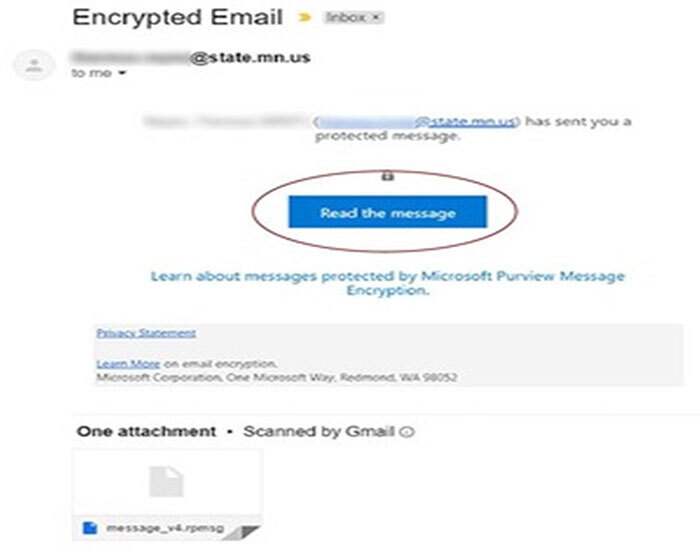
|
|
Fraud Awareness Week wraps up
Fraud Awareness and Prevention Week was Nov. 12-18. Gov. Tim Walz proclaimed the week to raise awareness of the various kinds of fraud that can happen in public and private sectors, and what people can do to prevent, detect and report them.
Fraud is knowingly misrepresenting the truth and purposely concealing facts to benefit oneself or another person by causing harm to others. These acts are different from honest mistakes or errors. Fraud is often difficult to detect and can happen anywhere, any time.
The first step in combatting fraud is trying to make sure it never happens in the first place. You can do this by identifying risks and putting in controls to address those risks.

Night visions
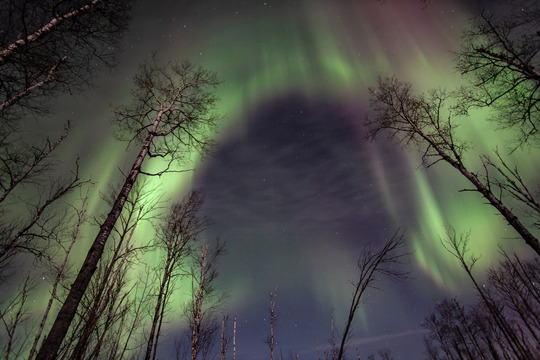 Photo credit: Travis Novitsky
By Travis Novitsky, Grand Portage State Park manager
My interest in photography was sparked during my elementary school years. My dad was into photography in a pretty big way and would often head out at night with his camera to try capturing lightning or the northern lights. My mom said I always wanted to tag along with him on these outings. I didn’t have a camera back then, much less know how to use one, but spending time under the night sky as he was making photographs instilled in me a love for stargazing.
We didn’t have computers, video games, or cell phones back then, so one of our sources of entertainment was “slide show night,” when we’d gather around the slide projector and view photographs that my dad had made. He was — and still is to this day — a very good photographer. Being exposed to his imagery helped me to develop my own way of seeing the world. Thanks to him, by the time I picked up a camera in about eighth grade, I already had an eye for what made a compelling photographic composition. In the years since, I have continued to develop my vision.
Minnesota Conservation Volunteer is the magazine of the DNR. Supported by reader donations, its mission is to encourage conservation and sustainable use of Minnesota’s natural resources. For more info, visit mndnr.gov/MCV or subscribe.
|
|
DNR recognizes veteran colleagues
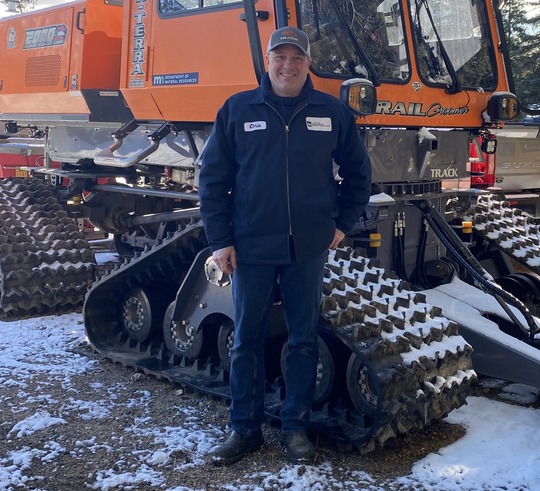 Chris Vest, a fleet supervisor for Region 2.
In November, the nation honors the strength and sacrifices of service members, their families and their caregivers. It's a time to pay respect for the bravery and dedication of all who have worn the uniform and to the unwavering support of those who stand alongside them.
This includes more than 200 of our veteran colleagues at the DNR, one of them being Chris Vest, a fleet supervisor for Region 2. Vest served in both the Minnesota Army National Guard and the Minnesota Air Guard.
"I experienced firsthand the support the state of Minnesota provides to its employees when I served stateside deployments, as well as extended overseas deployment," Vest said.
Vest said the technical training he received in the military provided a higher level of knowledge and skillset, which he uses as a heavy equipment mechanic and fleet supervisor.
The DNR is a proud Yellow Ribbon organization, meaning the agency is committed to supporting and giving back to veterans in our agency and throughout the state.
DNR staff create more than 250 cards to thank veterans
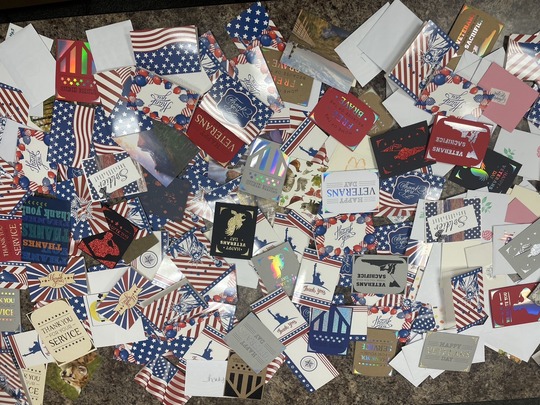 In honor of Veterans Day, DNR staff throughout the state composed 256 heartfelt notes of gratitude, which were forwarded to our veteran colleagues earlier this month.
The Beyond the Yellow Ribbon Committee is honored to continue the DNR's military support and recruitment efforts. This month and always, we salute our veterans and those who have served alongside them.
If you are connected to the military, the committee encourages you to voluntarily self-identify through a short survey. Your information is confidential, accessible only by the BTYR team, allowing team members to occasionally reach out to those listed, such as with cards collected during the annual Veterans Day card drive.
|
|
DNR staff raise $1,250 for food bank
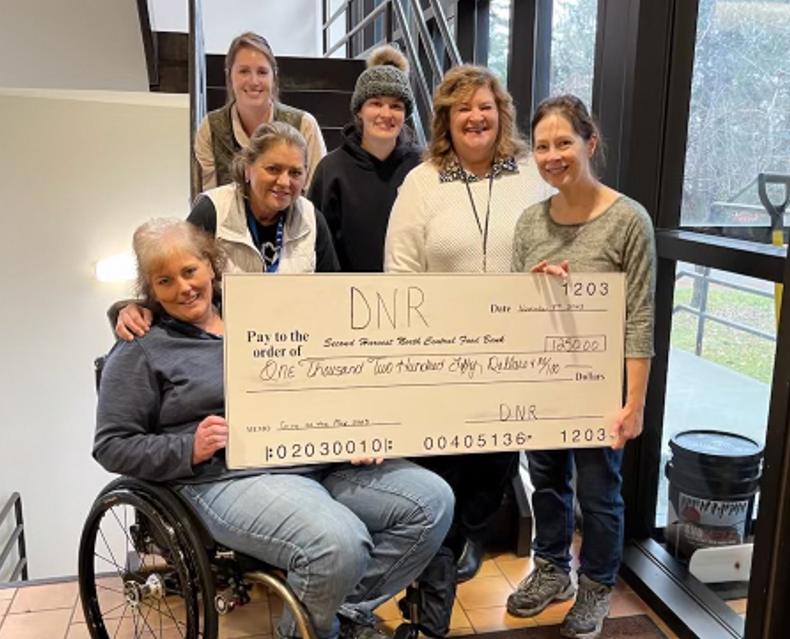 Front row: Rachel Schindler, Lexi Janecek; second row: Julie Ettl, Katie Petermeier; third row: Bella Oscarson; and fourth row: Hannah Leeper.
Northeast Region Headquarters employees in Grand Rapids held a series of fundraisers in the month of October to raise funds for the Second Harvest North Central Food Bank. In all, DNR staff raised and donated $1,250 to support families and individuals experiencing food insecurity in north-central Minnesota.
Fundraisers included a silent auction with items donated by staff, morning rolls and coffee sale, Crock-Chili cook-off (where staff voted for the best "shake the chill" chili), Crock-Dish hot dish contest (where staff voted for the best "Rockin' Crock"), a Crock-Soup contest (where staff voted for the "crowd favorite" and "most unique") and a match the pet with the owner contest.
|
|
Accounts Payable reminders
 Invoices
Stamps to use when processing invoices:
- Invoice received date stamp (blue)
- Goods and services received date stamp (yellow)
- Receipting and purchase order stamp (red)
- OK to pay stamp (green)
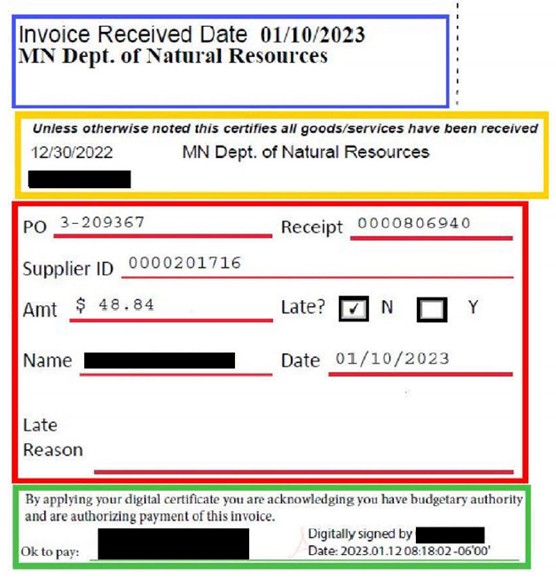 Review the PDF Basics – Accounts Payable document found on the Accounts Payable Intranet webpage for additional information, tips, and tricks for using Accounts Payable stamps.
Employee business expenses
Mileage calculations
Per the policy, “mileage reimbursement language can vary in collective bargaining unit agreements and compensation plans so consult yours for clarification. When an employee does not report to their office during the day, travels on a weekend or after hours or if the employee makes a business stop before or after reporting to their office, the allowable mileage for that day shall be:
- The lesser of the mileage from the employee’s residence to the first stop or from their permanent work location to the first stop.
- All mileage between points visited on state business during the day.
- The lesser of the mileage from the last stop to the employee’s residence or from the last stop to their permanent work location."
For example:
- A is residence to temporary work location
- B is temporary work location to permanent work location
- C is permanent work location to residence
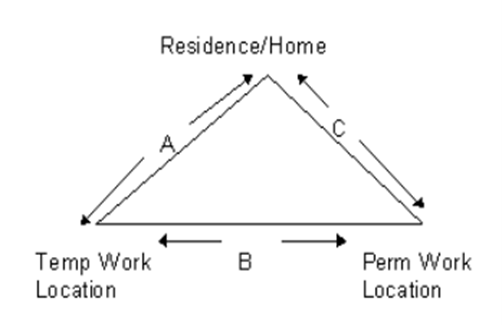 Refer to the Employee Business and Travel Expenses policy found under the policies and procedures section of the Administrative Manual for more information.
Purchasing cards
State sales tax
Per the policy, “cardholders must instruct the merchant to charge applicable state sales tax and local use tax when presenting the card for payment. Cardholders must check that the vendor did apply all applicable tax. If tax is not applied and it is appropriate, the cardholder must complete a taxes not paid form and submit with his/her monthly reimbursement packet for items where sales tax should have been charged but wasn’t. This applies to out-of- state purchases and online purchases.”
- Remember to check your receipt that local and county use taxes (where applicable) are also included in the sales tax amount.
- All sales and use tax amounts are calculated where you take possession of the item.
Hotel-specific state sales tax
The DNR is not exempt from sales, local, and lodging tax on hotel purchases, including in-state or out-of-state stays. Make sure the appropriate taxes are charged on your hotel receipt or include a new receipt to include the tax.
More information can be found on the Purchasing Card Use Policy which is located on the DNR EIOR System section of the intranet.

School Forest Coordinator Laura Duffey
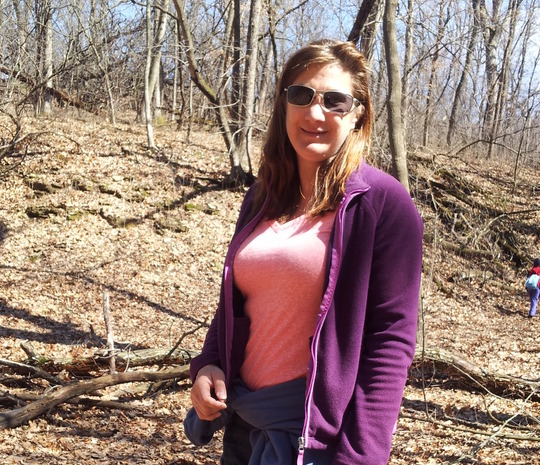
|
|
Supporting the “facilitators of discovery”
By Genna Soufflé, state lands outreach specialist
As the school forest coordinator with the Division of Forestry, Laura Duffey is no stranger to education.
In fact, she has a math problem of her own: how to manage and grow a program that supports 155 school forests across the state, each used by teachers of all stripes, serving countless students by providing them opportunities to learn in and about the outdoors.
So far, the answer is a passion for environmental education plus the help of Cooperative Forest Management Program foresters and what she calls the best teachers in the state. To be an educator, she said, is to be a “facilitator of discovery.”
“Connecting children with nature is the foundation of the DNR’s stewardship of the outdoors,” she said. "Without exposure and having a chance to connect to our natural resources, kids won’t be interested in recreating in the outdoors, much less want a career managing our forests, water, or wildlife."
Passed in 1949, the Minnesota school forest law allows schools to designate a piece of land – often school-owned or tax forfeit land – for use as an outdoor classroom. DNR foresters help the schools with management, including through timber harvests and terrestrial invasive species management, and school forests in the state range from proper forests to a few trees in a schoolyard. Teachers don’t just use them for education about nature – other subjects, like English or history, are also taught outside. That’s all part of the strategy for connecting kids with the outdoors.
“My definition for environmental education is teaching in nature, not about nature,” Laura said. “Because you are in nature, you will end up teaching about nature. But you have to be in nature first.”
Laura has been in her current position for a year, but she’s worked in environmental education for decades. She spent 20 years as the state’s Project Learning Tree coordinator, customizing environmental education curricula for Minnesota teachers.
|
 Work location:
Central Office
Job title:
School forest coordinator
Joined the DNR:
Began in 1992 as a student worker with the Division of Waters’ Adopt a River Program; returned in 2001 and worked with DNR and Forest Service for Smokey Bear (two years) and Project Learning Tree (20 years); and have been doing education and outreach since.
Education:
B.A. in English, M.S. in Environmental Education from the University of Minnesota
Something that might surprise your colleagues:
"My mom raised rough collies for show, and I grew up showing them in the ring all over the Midwest. I was a pretty mean handler back in the day!"
|
|
|
Laura grew up in Mendota Village, near the confluence of the Minnesota and Mississippi rivers. Having Dakota neighbors instilled an early interest in indigenous culture. Her neighborhood was a small rural pocket in the suburbs, but even growing up playing outdoors, she didn’t know natural resources could be a career. After graduating with a major in English and minor in journalism, she came to it almost by accident.
She said that like most English majors, she didn’t know what path to take. Her first experience working with natural resources was as a student worker with the Division of Waters in the Adopt a River Program. Once she knew the field existed, she came to love what everyone in the DNR did, fascinated by the research and stories of how people take care of our forests, trees, and resources.
“One thing I noticed off the bat were that scientists were so smart, but they didn’t know how to communicate with the public back then,” she said. “So I tried to bridge that gap.”
This passion led her to return to school for a Masters in Environmental Education, and she’s been helping translate for scientists since – though she noted they have grown much better at communication.
Prior projects using that expertise include shepherding the creation of state forest recreation maps, editing Forestry’s Roots newsletter for 12 years, and writing other Forestry publications. Over the years, she transformed her original intent of helping scientists communicate into a passion for teaching and education. But all her experiences are rooted in connecting people with natural resources.
“An old forester a long time ago told me, ‘We don’t just manage trees, we manage people,’” she said. “We have to invest in the people.”

From ancient lava to cold water
 Cold water splashes at Picnic Flow at Gooseberry Falls State Park, an area of shoreline on Lake Superior and the Gooseberry River formed from an ancient lava flow.
Photo credit: Michaela Rice, Gooseberry Falls and Split Rock Lighthouse state parks interpretive naturalist
|
|
Submit to Spotlight
Send Spotlight articles and photos to newsletter.dnr@state.mn.us.
Next Spotlight is scheduled for Dec. 1. Deadline for content is Nov. 29.
|
|
|
|
|